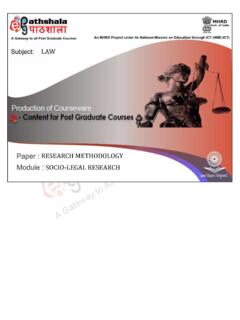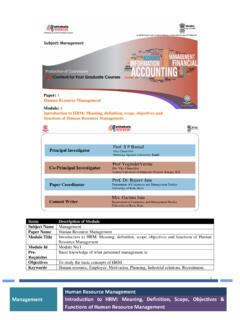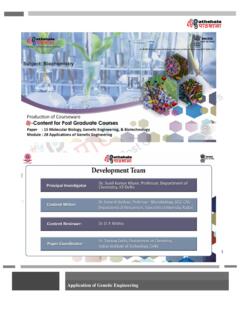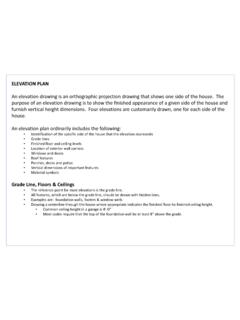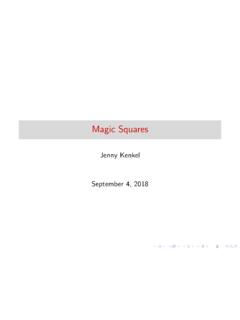Transcription of Module-2: Two probe and four probe methods- van der Pauw ...
1 Module-2: Two probe and four probe methods- van der Pauw method Measurement of Resistivity four probe Method The potential probe is most commonly employed method for measuring the resistivity of samples with low resistance value. Potential drop across two probes is measured and the gap between them (D) is taken as the sample length, L. If the probes are not point contacts, true value of probe distance is gap between the centers and not the shortest distance between them. Figure 1 displays schematic demonstration of the experimental procedure. Resistivity, , becomes: four probe method equally applies to single crystal or bulk samples and can determine their resistances. Current flows through outer contacts near the sample edges and potential difference is gauged across inner contacts. Hence effect of interfacial resistance between electrodes and sample is eliminated. Thus, it is precise technique for low resistance measurements.
2 Though the contact and probe resistance themselves are cancelled out, there is still possibility of error in measurements if the contacts produce heat. Therefore, low resistance of contacts is preferable. The error due to DC offsets in the instrument is readily overcome by subtraction. Additionally, self-induced voltage offsets within circuits can increase the error. This may be rectified by flowing reverse current in the sample. A small voltage (of the order of few microvolts) might develop across the sample, thereby adding signal noise and increases the error. This error can be reduced by shielding the cables, single point grounding, etc. Figure 1 four probe method for measuring electrical resistivity. The following conditions are required to satisfy for the resistivity measurement of a semiconductor. 1. The material possesses uniform resistivity in the measurement area. 2.
3 If minority carriers are injected in semiconductor via the current-conducting electrodes, much of these carriers recombine at the electrodes and they have negligible influence on conductivity. 3. Surface to place the probes should be flat without any surface leakage. 4. The probes employed in measurement should touch the surface in straight line. 5. Diameter of contacts between the probes and semiconductor should be smaller than the gap between the probes. 6. The material s surface can be either conducting or non-conducting. The boundary is conducting when a material having lower resistivity is deposited. Non-conducting boundary results from plating the semiconductor surface insulator. Applications: 1. Remote sensing areas. 2. Resistance thermometer. 3. Induction hardening processes. 4. Precise estimation ofgeometrical factors. 5. Characterization of fuel cells bipolar plates. A simple ohmmeter can be used measure the resistance of the contacts, samples, and cables connected to the sample.
4 In case of electrical contacts created with micromanipulators, the measurement of contact resistance becomes challenging due to the small contact problem of the contact resistance can be overcome using a four probe configuration. In this method, the current flows through the outer two probes, while the voltage is measured across the inner probes, as depicted in Figure 2. Figure 2 Equivalent circuit representation for a four point measurement. The current is injected in the sample through contact 1 and leaves the sample at contact 2. RS represents the resistanceof the sample, and RM represents the equivalent resistance of the voltmeter. VS repesents the voltage across the sample and VM is the measured voltage. four point measurements on a thin film As the current I is injected through the point contactsplaced on the sample(which is a thin conducting film)having a uniform resistivity ; the current spreads radiallyand the current density around the contact is given by: If two current contacts are placed on a thin film of thickness tand current I12is injected at positionr1into the surface while extracted from position r2, then the currents are being added producing following dipole pattern.
5 The thin film approximation is valid only if the inter spacing between the contacts is much larger than thefilm thickness. In such case the current density can be expressed as: Electric field can beobtained as the product of resistivity ( ) and current density, as: The measured voltage across r3 and r4 can be obtained by integrating the electric field from r3 tor4. Thus, the potential measured at r4 with respect to the potential at r3 can be expressed as: Since, measured voltage does not depend uponthe path taken for its measurement. So, we willintegrate first in x-direction and then in y-direction. The voltage obtained after performing integration can be expressed as: here, Resistivity can be obtained as: When the thickness of conducting film is not known, the term Rsquare(sheet resistance) is provided. Sheet resistance denotes the resistance of a square of the film. four point method for thick film resistivity A current I is injected through the contact placed on a flat surface of the sample.
6 The sampleis assumed to possess a uniform resistivity of .This current spreads radiallyand current density underneath the contact can be expressed as: The current density due to the current I12(injected into the samplefromr1 andcollectedat r2by placing two current contacts on flat surface)can be expressed as: Consequently, thick film approximation requires the distance between the contacts to be much shorter than product of resistivity and current density gives the electric field as: The potential at r4 with respect to r3 is: In the xy-plane, the voltage can be found by integrating first in x- and then in y-direction as: The voltage obtained after performing integration can be expressed as: where Finally, the expression for the resistivity of a thick film is: four point measurement for resistivity calculation on a thick film with edge-boundary condition A current I is injected through a current contact placed on a flat surface of the samplehaving a uniform resistivity , the current spreads radially along and the current density below the contact is given by: The current density due to the current I12is given by: If the contacts are near the edges of the sample, boundary effects appear which need to be considered.
7 This can be achieved by placing two image current sources near the edges of the sample. These additional current sources are mirror images of the real current sources, and the arrangement is shown as below: The expression for current density changes to accommodate the additional current sources as: The electric field becomes: Similarly, the voltage between positions r5 and r6 on the surface can be obtained by integrating the electric field from r5 tor6. Thus, the potential at r6 with respect to thepotential at r5is: in xy-plane, the voltage can be calculated as below: The resulting voltage from above integral comes out to be: where Finally, the expression for the resistivity is, Two probe Method Two probe technique is suitable for measuring resistivity of high resistivity samples, , polymer films/sheets. As shown in , the resistivity is calculated from the voltage drop (V) and current (I) as: Figure 3: Measuring electrical resistivity by two probe method.
8 Advantage of four probe method over two probe method four point probe is preferred than two-point probe as the contact and spreading resistances in two point probe are large and the true resistivity cannot be actually separated from measured resistivity. In the four probe method, contact and spreading resistances are very low with voltage probes and hence accuracy in measurement is usually very high. To measure very low resistance values, four probe method is used. The resistance of probe will be not be added to that of sample being tested. It uses two wires to inject current in the resistance and another two wires to measure the drop against the resistance. Van der Pauw method The van der Pauw technique is employed to determine resistivity and Hall coefficient of a material. It can accurately measure the sample s properties having any shape, if sample is two-dimensional, solid (without holes), and electrodes positioned on its perimeter.
9 It uses four -point probes positioned around the perimeter of the sample rather than in straight line. Therefore this method measures the average resistivity of the sample, while the linear arrangement measures resistivity only in the measuring direction. This difference is crucial to anisotropic materials, which can be efficiently characterized by Montgomery Method, an extension of van der Pauw Method. Following properties of a material can be measured by this method: resistivity doping type (p- or n-type) sheet density of majority carriers (majority carriers per unit area) charge density and doping level. mobility of majority carriers. Conditions: The following conditions must be met in order to apply this method: 1. sample must be flat shaped and uniformly thick 2. sample should not possess isolated holes 3. sample should be isotropic and homogeneous 4. contacts should be placed at sample edges 5.
10 Contact area of individual contacts must be smaller than sample area at least by an order of magnitude. Van der Pauw method to determine the resistivity of uniform sample This technique was invented by Van der Pauw, and isextensively employed in semiconductor industry for determination of resistivity of uniform samples. This techniquerequires an arbitrarily shaped thin-plate sample having four very small ohmic contacts placed on the periphery, usuallyat the corners , of the plate. Figure 4 shows the schematic arrangement of a typical Van der Pauw experiment. Figure 4 Schematics of a Van der Pauw experiment for determining the characteristic resistances RA and RB. In order to determine the resistivity of a uniform sample, the sheet resistance RS needs to be demonstrated by Van der Pauw, two characteristic resistances (RA and RB)are associated with the corresponding terminals as depicted in Figure 4.

